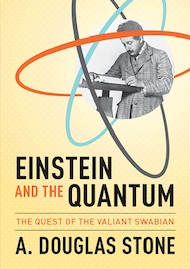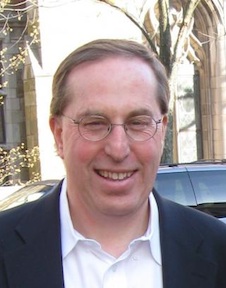
By Lisa McDonald
A. Douglas Stone, professor of applied physics and physics at Yale University, received Phi Beta Kappa’s Award in Science for his premiere book, Einstein and the Quantum: The Quest of the Valiant Swabian (Princeton University Press, 2013). For over fifty years the Award for Science has encouraged the literature of science through promoting works by scientists in the science and mathematical fields.
Stone earned his Ph.D. in theoretical condensed-matter physics from MIT. As a leading researcher in laser physics and quantum effects in nanostructures, he has been honored with many awards throughout his career including the Rhodes Scholar in 1976, Fellow of the America Physical Society in 1993, and most recently, Fellow of Optical Society of America in 2010.
Einstein and the Quantum is the first of its kind to explicitly describe the pivotal role Albert Einstein played in the development of quantum physics, an achievement often overlooked since Einstein himself ultimately ended up decrying the very science he had worked so hard to shape. By following along Einstein’s path through use of publications and personal letters, this book not only takes the veil off who was the true driving force behind the quantum phenomenon but also demonstrates the collaborative work that is the core of shaping any scientific field.
INTERVIEW
While there have been tons of biographies done on Einstein, none have emphasized the pivotal role he played in the development of quantum physics. Can you tell us about what first inspired you to look into Einstein’s contributions in this dynamic field?
STONE: A key moment was when I discovered (through the works of T.S. Kuhn and others) the true story of Planck’s introduction of the constant h and the equation energy = h time frequency (ε = hν) in 1900. It turns out that Planck was not at all proposing quantization of energy as a new law of mechanics or as required by the existence of photons, but rather as a kind of provisional hypothesis that could perhaps be dropped later. This is such a gripping episode in the history of science that I chose to start the book with it. It places Einstein’s 1905 work on quanta of light and his 1907 work on mechanical vibrations in solids in a completely different perspective: it was Einstein, not Planck who understood the necessity of the quantum revolution and was its primary driver in the early phase. Once I understood this, it was natural to ask about the total influence of Einstein’s work on quantum theory, which I discovered to be much greater than is typically portrayed.
Known as he is for his scientific advancements the title of the book have caught some people off guard. How does the title of valiant Swabian apply to this esteemed man?
STONE: The Valiant Swabian was a delightful nickname that Einstein, who was born in the southern German region of Swabia, used for himself with his first wife, Mileva Marić, before 1905. It refers to a brave and crafty crusader knight whose exploits were immortalized in a romantic poem. For me, it exemplified Einstein’s whimsical nature and captured a period in his life in which he was truly no different from a struggling artist, living hand to mouth, while fighting for recognition. At that time he was a feistier, more arrogant character than the saintly savant we came to know in his later years.
Throughout Einstein’s life he was known for being a stand-alone physicist who developed many of his ideas without the help of his peers. Yet his widely considered last major contribution to physics was the famous “EPR” experiment conducted with the collaboration of Boris Podolsky and Nathan Rosen. What led Einstein to work with these young scientists in his search for a disparagement of the Copenhagen interpretation when he so often preferred to work alone?
STONE: As you no doubt noticed, I don’t discuss EPR at all in the book (except for a footnote) because I wanted to emphasize Einstein’s contributions to the foundations of quantum mechanics and not his opposition to the theory in its final form (about which much has been written previously). Nonetheless, based on what I have read it seems that Einstein wanted to have co-authors who were using quantum mechanics in their technical work (which he was not) to confirm that his understanding of its inherent non-locality was correct and that the calculations were airtight. He also wanted to publish in English (in which he was not fluent) and in the end Podolsky wrote most of the text. I also have read that he was unhappy with how it came out in terms of clarity.
In your introduction for Einstein and the Quantum you discuss the reason physics classes neglect discussing the history of development is because it is “daunting enough to attempt to master and then extend” without involving the added missteps that the famous scientists had to go through to reach the solution. Do you feel students would benefit if the full history was incorporated into more of the curriculum?
STONE: I have found that students very much enjoy and also find helpful learning some of the historical context. It can emphasize to them just how surprising are some of the concepts they are learning. A fun example is that of Bose-Einstein statistics which I explain in the book in terms of two “quantum coins” that can be in an indeterminate state of heads-tails or tails-heads. In 1925 Schrodinger read Einstein’s paper on this new approach to statistical physics and wrote Einstein to say that he had made an error in his paper. Einstein replied by saying that his reproach was “not unjustified” but “I have made no error”. He then explains what is going on with a small pair of diagrams, which are exactly equivalent to the case of two quantum coins. I show the students the letter with the diagrams in Einstein’s own handwriting – they love it and I think it cements the new concept in their minds. Moreover, that exchange with Einstein played a role in Schrodinger’s discovery of the basic equation of quantum mechanics.
While you have had many years to hone your skills as a professor, this is the first time you’ve tackled the challenge of becoming an author. What discoveries along this journey have had the most impact on you?
STONE: The actual writing was great fun and rarely felt onerous. It gave me a chance to express my sense of humor in the style, something frowned upon in the writing of scientific papers. As you know, the book is written with almost no equations or complicated diagrams, so I set out to make it accessible to the interested layperson without a technical background. Nonetheless I was continually reminded that understanding these concepts is a lot of intellectual work and I needed to find the right compromise between being true to the concepts but not overloading the reader with more than he/she can handle. Finally, I discovered just how special it is to hear from readers who had enjoyed the book and had even been moved by it. I realized that it is different kind of contribution to society than one’s scientific work.
In today’s society quantum mechanics is often used as a novelty term but the true impact it holds outside of academia doesn’t get discussed. What significance do the discoveries of Einstein and others almost a century ago hold for the average person of today?
STONE: Perhaps the most important point of the book, even beyond deepening our understanding of Einstein, is to emphasize the revolutionary role of quantum mechanics on modern society. In 1900 scientific progress faced a fundamental obstacle: we did not understand the laws of the atoms that make up our world. No previous civilization had even been able to approach these questions in a serious manner and it wasn’t clear that human beings were capable of discovering the answers. However between 1900 and 1926 the heroic generations of Planck, Einstein, Bohr, Heisenberg, Schrodinger and Dirac succeeded. Our modern world is inconceivable without that success; computers, mass telecommunications, nuclear energy, solar energy, novel materials…all rely on this basic understanding of the atom and of light.
What do you think your readers will be most surprised to find attributed to Einstein out of all the contributions he made to quantum mechanics?
STONE: Einstein is famous for his “God does not play dice” quote, expressing antipathy to the random element in the laws of quantum mechanics. In quantum mechanics as we now know it, individual events, for example, when a specific atom emits a photon, do not have a specific prior cause. The most we can say is that once the atom has enough energy to emit a photon, it will do so at a certain rate, but no law of nature determines exactly when the single photon comes out. Thus we allow that there are uncaused, intrinsically random events, something which did not exist in Newtonian physics. However I was surprised to realize that it was Einstein who first introduced this concept into quantum theory, specifically in his 1916-17 papers on the emission of photons by atoms. Bohr had come earlier and introduced quantum jumps, but did not insist on their intrinsically random nature. So when Einstein was complaining about this, it wasn’t against something foreign which others had proposed, but against a concept he himself had introduced (albeit always expressing some reservations).
What does winning the Phi Beta Kappa Award in Science mean to you?
STONE: This is a tremendously meaningful award for me. As a first time author it is an enormous honor to have my work placed alongside superb science writers whom I have admired such as James Gleick, Brian Greene, and Freeman Dyson. Having the opportunity at the awards ceremony to meet and discuss writing with the winners in the other categories was also a great thrill.
Lisa McDonald is a sophomore at Coe College majoring in Physics and Communication Studies. Coe College is home to the Epsilon of Iowa Chapter of Phi Beta Kappa.




